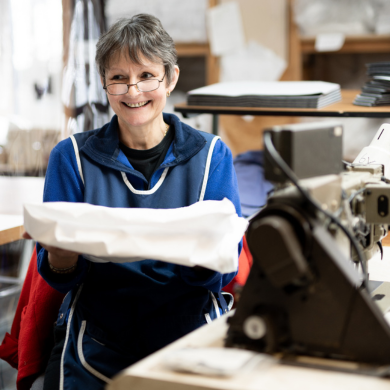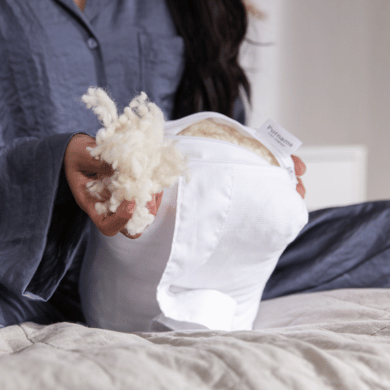
A Complete Guide to Choosing the Right Pillow for Stroke Recovery
Getting through a stroke is a major victory, but the path to recovery can be long and challenging. Among the many tools available to help stroke survivors, the humble pillow stands out as a crucial companion on this journey.
This guide will walk you through how the right pillow can significantly enhance stroke recovery, improve sleep quality, and provide essential support to enhance your rehabilitation.
Remember sleep is the 'silent healer', it is one of the key tools in your arsenal that help facilitate the BEST recovery for you. Sleep is the time when your brain has the opportunity to refile all those memories and lifetime learnings that allow you to be who you are!
How Stroke Affects Sleep and Rest
After a stroke, sleep disruptions are common. Choosing the correct pillows for sleep after a stroke can be a game changer.
Many stroke survivors experience insomnia, with studies showing that between 35% to 42% of patients struggle with sleep disturbances. The severity of these disturbances often correlates with the stroke's severity. Post-stroke fatigue is another frequent issue, which can impact overall quality of life and slow down the recovery process.
Enduring insomnia or sleep apnoea post-stroke isn't just frustrating; it can also impede healing. Sleep is vital for brain recovery and the formation of new neural connections. Without restful sleep, the brain's ability to repair itself is compromised.
Therefore, ensuring good sleep is a significant aspect of stroke rehabilitation.
The right pillow can play an essential role here.
By providing the necessary support to the head, neck, and spine, pillows can help align the body correctly, promoting better sleep and rest. This alignment reduces instances of disrupted breathing patterns, like those seen in sleep apnoea, thereby enhancing sleep quality.
Importance of Proper Head and Neck Support
Proper head and neck support is vital for everyone, but particularly for stroke survivors. Due to muscle weakness or paralysis, stroke patients might face difficulties in maintaining proper posture, both when awake and asleep.
This can lead to discomfort and further strain on the body, exacerbating the recovery process.
A supportive pillow helps in maintaining spinal alignment. It supports the natural curve of the neck, reducing stress and tension in the upper body. For stroke survivors, this support is crucial to prevent added physical strain that could lead to pressure sores or increase the risk of shoulder pain.
When choosing a pillow, consider options that offer firm support while being comfortable. This balance is key to ensuring the spine remains aligned, and the muscles don't have to compensate for improper positioning.
Specialised Pillows for Stroke Recovery
Not all pillows are created equal, and for stroke recovery, specialised options can make a world of difference. Selecting the correct pillow for stroke recovery is very bespoke so take your time and take advice.
Wedge pillows, orthopaedic pillows, and contour pillows each serve distinct purposes that cater to the unique needs of stroke survivors.
Wedge pillows are designed with an elevation feature that supports the upper body. This elevation aids in better breathing by keeping the airways open, reducing the risk of aspiration during sleep. It's especially beneficial for those dealing with sleep-disordered breathing.
Orthopaedic pillows offer firm support that maintains proper spinal alignment. This type of pillow alleviates pressure on the body, reducing the risk of developing pressure sores - a common concern for those with reduced mobility.
Contour pillows are crafted to support the natural curve of the neck, ensuring a comfortable and aligned sleep posture. For stroke patients with limited mobility, these pillows can provide consistent support throughout the night, reducing restlessness.
Reducing Pressure on Affected Areas
Pressure sores are a serious concern for some stroke survivors, given the reduced mobility and prolonged periods spent in one position. It is crucial to minimise pressure on affected areas to promote healing and prevent further complications.
Stroke recovery pillows can play a pivotal role in achieving this.
By cushioning various body parts, they help distribute weight more evenly, reducing pressure points. For instance, placing pillows under the arms and legs can alleviate stress on these areas, preventing sores and discomfort.
Using specialised pressure-relief pillows, such as memory foam or gel-infused options, can be the perfect support pillows for better circulation.
These materials conform to the body's shape, offering personalised comfort and reducing localised pressure effectively.
Pillows for Improved Breathing and Circulation
The correct pillows for stroke patients with impacted breathing and circulation can be tricky. A well-chosen pillow can aid in enhancing both these areas, thus supporting overall recovery.
Elevating the upper body with a wedge pillow can significantly improve breathing. By doing so, it reduces the likelihood of airway obstruction and sleep apnoea, common issues among stroke survivors. This elevation also promotes better circulation by aiding blood flow, particularly beneficial for preventing blood clots.
Cooling pillows, featuring materials that dissipate heat, can help manage temperature for stroke patients who may experience thermal dysregulation. Maintaining a comfortable temperature during sleep can prevent excessive sweating, ensuring a more restful night.
Tips for Positioning and Comfort Post-Stroke
Achieving the right position during rest and sleep is critical for stroke recovery. Proper positioning aids in reducing muscle stiffness, easing pain, and promoting comfort. Here are some practical tips:
- Side Lying Support: When lying on the unaffected side, ensure the affected arm and leg are supported with pillows to prevent rolling and maintain spinal alignment. This reduces the risk of developing contractures or additional strain.
- Supine Positioning: If lying on the back is preferred, use a small pillow under the shoulders, head, and weaker arm. Ensure the feet are placed in a neutral position to avoid rotation, which can strain the hips and knees.
- Upright Resting: For those who spend time sitting up, ensure the head is supported with a cushion to maintain neck alignment. This can prevent slouching, which might lead to discomfort and impede breathing.
The Perfect Pillow Prescription for Stroke Recovery
For stroke survivors, recovery is a multifaceted process that extends beyond traditional medical interventions. A supportive pillow can be an invaluable partner in this journey, aiding in better sleep, improved physical recovery, and enhanced comfort.
Choosing the right pillow involves considering factors like support, pressure relief, and material comfort, with specialised options available to cater to the unique needs of stroke recovery. By prioritising sleep and comfort, stroke survivors and caregivers can take proactive steps towards a smoother rehabilitation process.
If you're navigating stroke recovery or supporting someone who is, consider consulting with a healthcare professional or a physical therapist for personalised recommendations. And for those seeking expert pillow guidance, feel free to call us at Putnams where we offer insights into selecting the perfect pillow tailored to your needs.
“Promise me you’ll always remember: You’re braver than you believe, and stronger than you seem, and smarter than you think.”
– A.A. Milne (Christopher Robin to Pooh)


















Leave a comment